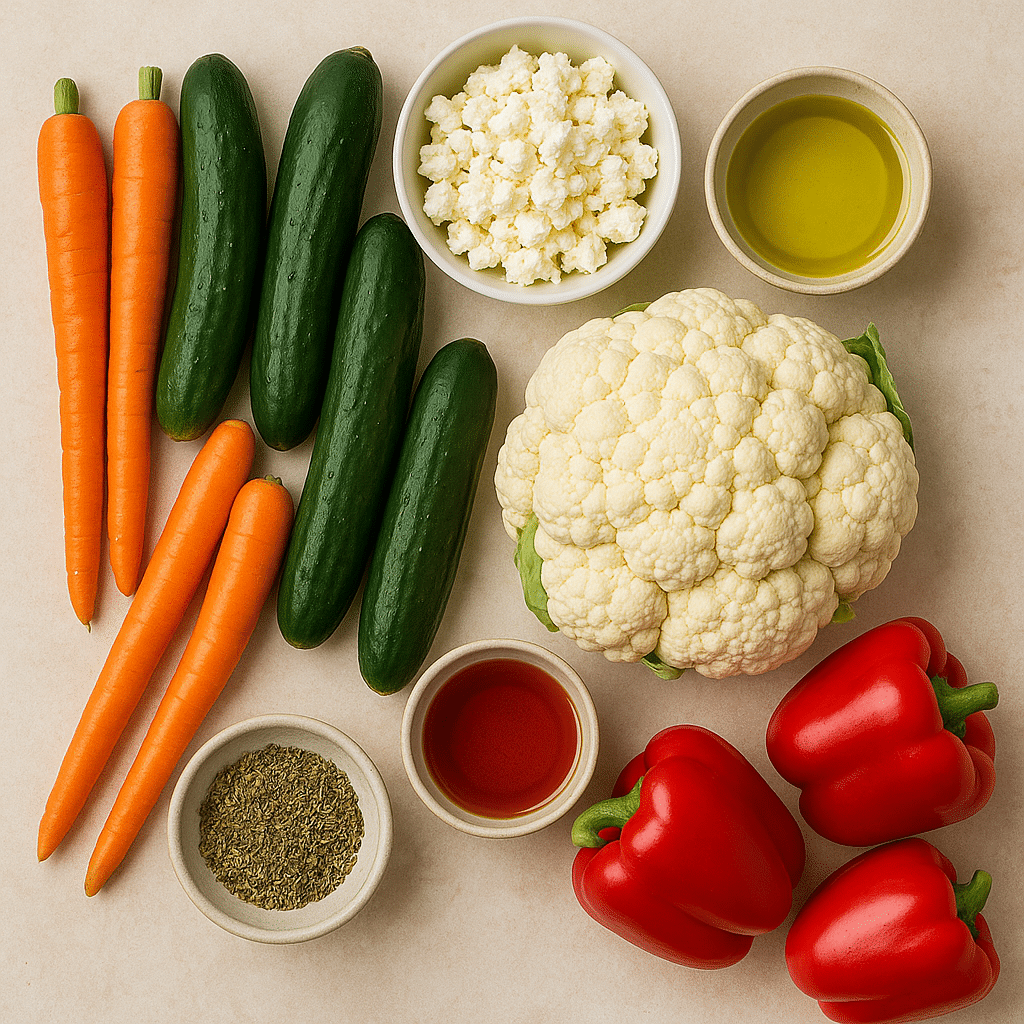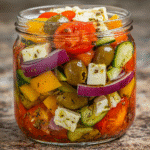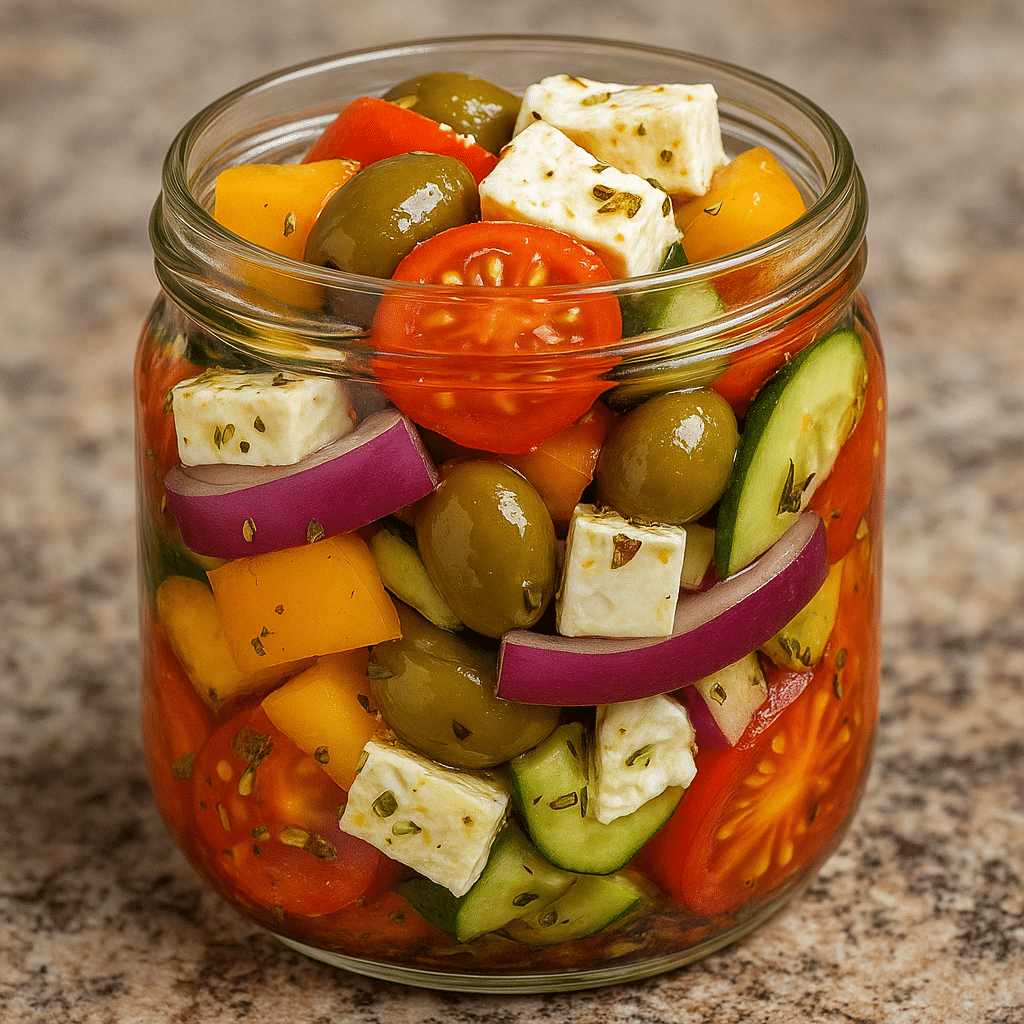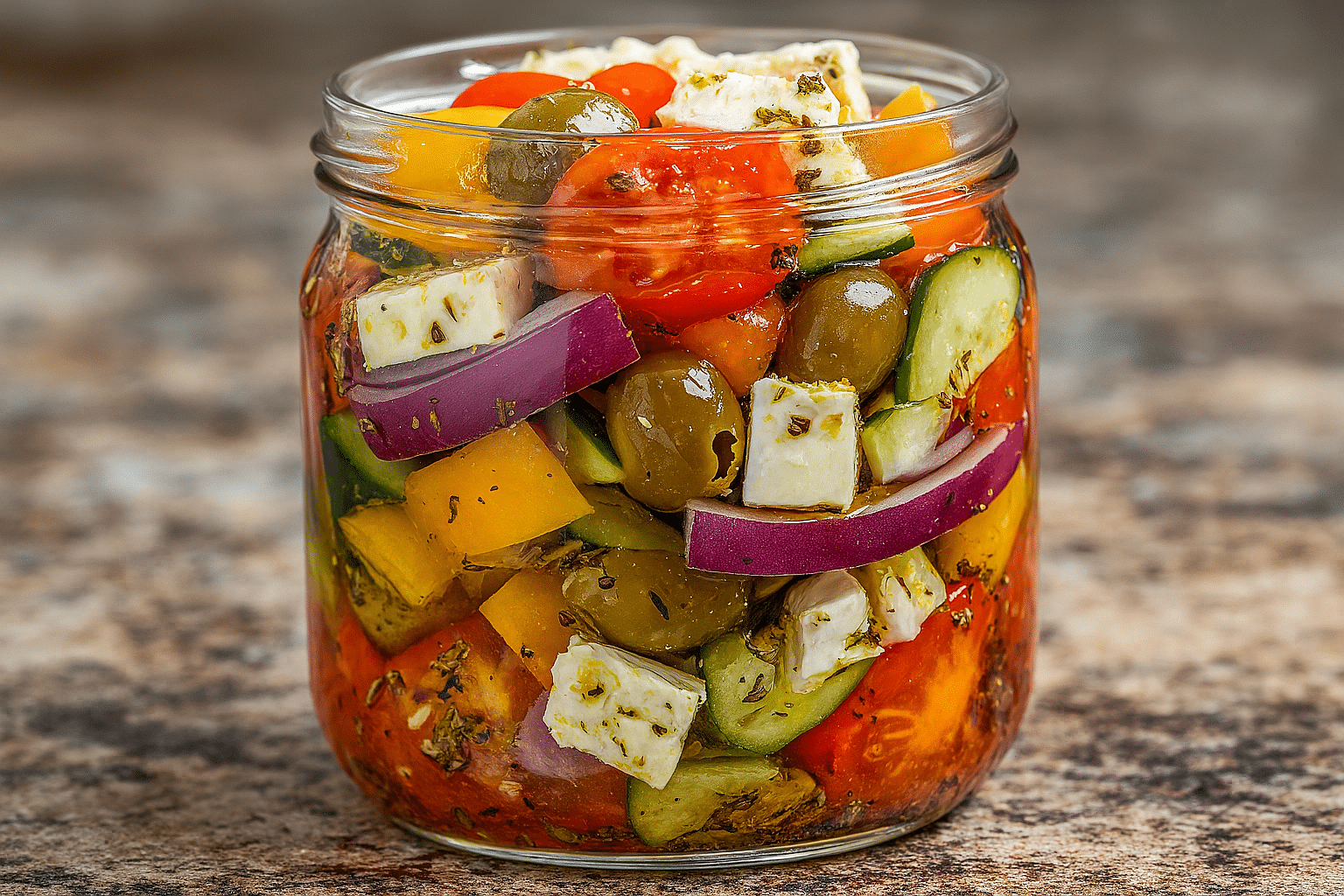Introduction
If you’re craving a bold and refreshing bite that captures the essence of the Mediterranean diet, zesty Mediterranean pickled veggies with feta & oregano are the way to go. This flavor-packed dish brings together crisp seasonal vegetables, tangy brine, and creamy feta, all seasoned with aromatic herbs like oregano. Whether served as part of a mezze platter, layered into sandwiches, or eaten straight from the jar, this colorful combo offers a mouthwatering contrast of textures and flavors.
Pickled vegetables are a Mediterranean staple, not just for their bold taste but also for their health benefits and ease of preparation. In this guide, we’ll walk you through every step of making your own Mediterranean-style pickled veggies, from ingredient selection to storage tips, health perks, and fun flavor variations.
Discover great ideas like Hawaiian Pineapple Carrot Muffins to pair with savory sides like this one.
Table of Contents
How to Make Zesty Mediterranean Pickled Veggie
Step-by-Step Pickling Method
Making Mediterranean pickled vegetables at home is simple and quick. Here’s a classic recipe that delivers balanced zest and crunch in every bite:
Ingredients for 2 jars (16 oz each):
- 2 carrots, sliced thin
- 1 cucumber, cut into sticks
- 1 cup cauliflower florets
- 1 red bell pepper, julienned
- 2 garlic cloves, halved
- 1/2 cup white or apple cider vinegar
- 1/2 cup water
- 1/4 cup olive oil
- 1 tsp salt
- 1/2 tsp black pepper
- 1 tsp dried oregano
- 1/2 cup crumbled feta (added after pickling)
Instructions:
- Wash and cut all veggies into uniform pieces.
- In a saucepan, combine vinegar, water, salt, pepper, garlic, and oregano. Bring to a light boil.
- Pack veggies tightly into clean glass jars.
- Pour hot brine over the vegetables, making sure they’re fully submerged.
- Let cool slightly before sealing the jars.
- Refrigerate for 24–48 hours for full flavor development.
- Add feta just before serving or layer it into the jar for stronger infusion.
You can store the jars in the fridge for up to 2 weeks.
Pro Tips for Getting the Perfect Tangy Crunch
- Use fresh, firm vegetables: Avoid overripe or soft veggies; they won’t hold up well in brine.
- Slice uniformly: Even cuts ensure consistent pickling and texture.
- Don’t overheat the brine: Boiling it too hard can destroy delicate flavors.
- Add feta at the end: Feta will break down in vinegar over time—add it fresh for the best creamy contrast.
- Let it sit: While they can be eaten after a few hours, the flavor really pops after at least 24 hours.
Looking for inspiration? Try Blue Salt Trick Recipe to explore unique brine techniques.
Ingredients Overview and Nutritional Value

Key Ingredients: Fresh Vegetables, Feta, Oregano, Vinegar, Olive Oil
To make authentic zesty Mediterranean pickled veggies with feta & oregano, the ingredients must be simple yet high quality. Here’s a closer look at what you’ll need:
| Ingredient | Purpose |
|---|---|
| Carrots | Add sweetness and crunch |
| Cucumbers | Classic pickling veggie with a refreshing bite |
| Cauliflower | Earthy, hearty base with good soak-up ability |
| Red Bell Peppers | Sweet, colorful, and mildly tangy |
| Garlic Cloves | Infuse pungency and depth |
| White or Apple Cider Vinegar | Creates the tangy brine base |
| Extra Virgin Olive Oil | Adds richness and balances acidity |
| Dried Oregano | Offers earthy Mediterranean herbaceous flavor |
| Feta Cheese (crumbled or cubed) | Adds saltiness and creamy texture |
| Salt & Black Pepper | For seasoning and brine balance |
Each ingredient plays a role in the overall taste and texture profile. You can swap in other seasonal vegetables if desired—just make sure they’re firm and not too watery.
Check out Hello Fresh Carrot Recipes for more ways to use seasonal veggies creatively.
Print
Zesty Mediterranean Pickled Veggies with Feta & Oregano: A Bold & Healthy Snack
- Total Time: 20 minutes
- Yield: 2 jars (16 oz each) 1x
Description
If you’re craving a bold and refreshing bite that captures the essence of the Mediterranean diet, zesty Mediterranean pickled veggies with feta & oregano are the way to go. This flavor-packed dish brings together crisp seasonal vegetables, tangy brine, and creamy feta, all seasoned with aromatic herbs like oregano. Whether served as part of a mezze platter, layered into sandwiches, or eaten straight from the jar, this colorful combo offers a mouthwatering contrast of textures and flavors.
Ingredients
- 2 carrots, sliced thin
- 1 cucumber, cut into sticks
- 1 cup cauliflower florets
- 1 red bell pepper, julienned
- 2 garlic cloves, halved
- ½ cup white or apple cider vinegar
- ½ cup water
- ¼ cup olive oil
- 1 tsp salt
- ½ tsp black pepper
- 1 tsp dried oregano
- ½ cup crumbled feta (added after pickling)
Instructions
Wash and cut all veggies into uniform pieces for even pickling and texture.
In a saucepan, combine vinegar, water, salt, pepper, garlic, and oregano. Bring to a light boil.
Pack veggies tightly into clean, sterilized glass jars.
Pour hot brine over the vegetables, making sure they’re fully submerged.
Let the jars cool slightly before sealing them with lids.
Refrigerate for 24–48 hours for full flavor development.
Add crumbled feta just before serving or layer it into the jar for stronger infusion.
Notes
- Use fresh, firm vegetables: They hold their shape and texture better.
- Don’t overheat the brine: Boil just until hot to preserve flavor.
- Add feta at the end: Avoid letting feta break down in acidic brine.
- Label and date your jars: For freshness tracking.
- Prep Time: 15 minutes
- Cook Time: 5 minutes
- Category: Side Dish or Appetizer
- Method: Pickling
- Cuisine: Mediterranean
Nutrition
- Serving Size: 2 jars (16 oz each)
- Calories: 90–120 g
- Fat: 2–4g
- Protein: 4–6g
Nutritional Benefits of Pickled Vegetables and Feta
This dish isn’t just flavorful—it’s also a powerhouse of nutrition. Here’s what makes it a guilt-free indulgence:
- Low in Calories: Most of the vegetables used are naturally low in calories while being high in fiber and water content.
- High in Antioxidants: Red bell peppers, garlic, and oregano are rich in vitamins and antioxidants that fight inflammation.
- Probiotics Potential (when fermented): If you opt for a naturally fermented brine (with no vinegar), your veggies could carry gut-healthy probiotics.
- Calcium and Protein: Feta adds calcium and a small protein boost, which helps with bone health and satiety.
- Heart-Healthy Fats: Olive oil provides monounsaturated fats, shown to reduce the risk of cardiovascular disease.
This combo makes for a tasty snack or side that supports digestive health, immune function, and long-lasting energy.
The Best Vegetables for Pickling Mediterranean Style
Top Choices: Peppers, Cucumbers, Carrots, Cauliflower
When making zesty Mediterranean pickled veggies with feta & oregano, the choice of vegetables can make or break your recipe. Texture, color, and flavor compatibility all matter.
Here are some of the top vegetables traditionally used in Mediterranean-style pickling:
| Vegetable | Flavor Profile | Texture After Pickling |
|---|---|---|
| Red Bell Peppers | Sweet and mild | Soft with a bite |
| Cucumbers | Crisp, refreshing | Crunchy if pickled properly |
| Carrots | Slightly sweet | Firm and crisp |
| Cauliflower | Earthy and mild | Slightly chewy yet tender |
| Red Onions | Sharp and zesty | Soft with sweetness |
| Radishes | Peppery | Very crunchy, a sharp bite |
| Zucchini | Mild and neutral | Soft and sponge-like |
Each vegetable brings something unique to the jar—color, taste, texture, or all three. Combining these veggies creates a rich medley of Mediterranean flavor that pairs beautifully with feta.
Why Texture and Water Content Matter
Texture plays a vital role in pickled vegetables. You want your final result to have that satisfying crunch—not soggy or mushy bites. Vegetables like carrots, cauliflower, and radishes hold their shape well due to low water content and sturdy structure.
On the flip side, high-water veggies (like zucchini or cucumbers) require a bit of prep. Sprinkle them with salt and let them sit to draw out excess moisture before pickling. This prevents the brine from becoming too diluted and the veggies from going limp.
When choosing veggies, opt for ones with:
- Firm flesh
- Thin skins
- Mild sweetness or earthiness to complement the brine
Don’t miss our Brazilian Mounjaro Recipe if you’re into flavor-packed veggie recipes with international flair.

Storing and Serving Suggestions
How to Store Pickled Veggies Safely
Proper storage is key to keeping your zesty Mediterranean pickled veggies with feta & oregano fresh and flavorful.
Here’s how to store them safely:
- Use sterilized glass jars to prevent contamination.
- Refrigerate immediately after the brine cools slightly.
- Keep veggies fully submerged to maintain their flavor and prevent spoilage.
- Label with date so you know when they were made.
Typically, pickled vegetables last up to 2 weeks in the refrigerator. Feta can be added during serving time or kept in a separate container to avoid softening too quickly.
Tip: Don’t freeze pickled veggies—they lose texture and can become watery.
Creative Ways to Serve with Feta and Oregano
Ready to enjoy your pickled creations? Here are flavorful ways to serve them:
| Serving Style | Description |
|---|---|
| As a Mezze Side | Pair with olives, hummus, pita, and dolmas |
| In Salads | Toss with arugula, cherry tomatoes, and olive oil drizzle |
| In Sandwiches or Wraps | Layer into pita pockets with grilled chicken or falafel |
| On Cheese Boards | Add colorful zing alongside cheeses and nuts |
| With Grilled Meats or Seafood | Add acidity to balance heavy or fatty proteins |
Oregano brings depth, while feta offers creaminess, creating harmony in every bite. You can even drizzle some olive oil over the jar and serve as a cold antipasto.
Check out Natural Mounjaro Recipe for another clean and nourishing Mediterranean-inspired idea.
Health Benefits of Pickled Mediterranean Foods
Gut Health and Probiotics
When it comes to functional foods, zesty Mediterranean pickled veggies with feta & oregano aren’t just delicious—they’re a smart choice for digestive health too. The pickling process, especially when done naturally (without vinegar), encourages fermentation, which creates beneficial bacteria known as probiotics.
Probiotics help:
- Balance gut microbiota
- Improve nutrient absorption
- Enhance immune response
- Reduce bloating and indigestion
While this particular recipe uses vinegar (not a probiotic fermentation), it still supports gut health by incorporating fiber-rich veggies and fermented feta, which contains healthy bacterial strains.
Add to that oregano’s natural antibacterial properties and you’ve got a gut-friendly side dish that packs a punch.
Low-Calorie, High-Nutrient Snack Option
One of the biggest reasons to enjoy zesty Mediterranean pickled veggies with feta & oregano is how satisfying they are—without loading you up on calories.
Here’s a quick look at what a typical serving (1 cup) might provide:
| Nutrient | Approximate Amount |
|---|---|
| Calories | 90–120 kcal |
| Protein | 4–6g |
| Fiber | 2–4g |
| Healthy Fats | 6–8g (from olive oil and feta) |
| Calcium | 10–15% DV |
| Vitamin C | 20–30% DV |
You get a crunchy, savory treat with real substance—no fillers, no processed sugars, no artificial preservatives. It’s ideal for clean eating and anyone following a Mediterranean or low-carb lifestyle.
With bold ingredients like feta, vinegar, oregano, garlic, and fresh vegetables, this side dish naturally helps curb cravings and supports metabolic function.
Variations and Flavor Twists
Add-ons Like Garlic, Lemon Zest, or Chili Flakes
One of the best things about zesty Mediterranean pickled veggies with feta & oregano is how easily they can be customized. Here are flavorful additions that dial things up a notch:
- Fresh Garlic Slices: Add intense aroma and antimicrobial properties.
- Lemon Zest: Boosts brightness and enhances the feta’s creaminess.
- Crushed Red Pepper Flakes: Introduces heat that plays beautifully with tangy pickled veggies.
- Fresh Dill or Thyme: Layered herbal complexity beyond oregano.
- Capers or Kalamata Olives: For that extra briny, bold Mediterranean bite.
These extras not only intensify the flavor but also bring variety to each jar, making them feel gourmet—even on a weeknight.
Different Vinegar Bases: Red Wine, Apple Cider, White Balsamic
The type of vinegar you choose can completely change the taste of your Mediterranean pickled veggies with feta & oregano:
| Vinegar Type | Flavor Profile | Best Pairings |
|---|---|---|
| White Vinegar | Clean and sharp | Pure veggie pickling |
| Apple Cider | Sweet-tart with subtle fruitiness | Pairs well with carrots & peppers |
| Red Wine Vinegar | Bold and slightly fruity | Perfect with olives and onions |
| White Balsamic | Smooth and mildly sweet | Great with feta and oregano |
Feel free to experiment and find your ideal flavor combo. Want a more rustic feel? Try mixing vinegar types. Going sweeter? Add a splash of honey or a few raisins to your brine.
For those who crave bold flavors, adding zesty Mediterranean pickled veggies with feta & oregano to your routine offers a never-boring, always-delicious twist.
FAQ: Zesty Mediterranean Pickled Veggies with Feta & Oregano
What are Mediterranean pickled vegetables?
Mediterranean pickled vegetables are a vibrant mix of firm, fresh veggies preserved in a tangy vinegar-based brine seasoned with herbs like oregano, garlic, and sometimes lemon zest. Common veggies include carrots, cauliflower, cucumbers, bell peppers, and onions. These pickles are often served as mezze or antipasto, paired with creamy feta, olives, and crusty bread for a bold, flavorful experience.
How do you make Mediterranean pickled veggies with feta?
To make zesty Mediterranean pickled veggies with feta & oregano, start by slicing fresh vegetables like carrots, cucumbers, and bell peppers. Pack them into sterilized jars, then pour over a hot brine made of vinegar, water, salt, pepper, olive oil, garlic, and dried oregano. Once cooled and stored in the fridge for at least 24 hours, add crumbled feta before serving for a creamy, tangy finish. The feta should not be pickled in the brine for long periods—it’s best added fresh to preserve texture and flavor.
Are pickled vegetables healthy?
Yes, pickled vegetables—especially Mediterranean-style—can be a healthy snack or side dish. They’re low in calories, high in fiber, and offer gut-friendly benefits when fermented. When paired with healthy fats from olive oil and nutrient-rich feta, they provide a satisfying, balanced option. Just be mindful of sodium levels in the brine.
What vegetables are best for Mediterranean pickling?
Firm and low-moisture vegetables work best for pickling. Top choices include:
Carrots
Cauliflower
Cucumbers
Red bell peppers
Red onions
Radishes
These veggies retain crunch and absorb the oregano-garlic brine well, creating a satisfying bite every time.
How long do pickled vegetables last in the fridge?
When stored properly in sterilized jars and fully submerged in brine, Mediterranean pickled vegetables can last up to 2 weeks in the refrigerator. Keep them tightly sealed and always use clean utensils to extend freshness. Feta, if included, should be added at serving time to prevent spoilage.
Can you pickle feta cheese with vegetables?
Technically, you can add feta to the jar, but it’s not ideal for long-term storage in acidic vinegar-based brine. Feta tends to break down over time and may alter the texture of the entire mix. Instead, add feta fresh when serving your zesty Mediterranean pickled veggies with oregano to maintain its creamy contrast and bold flavor.

